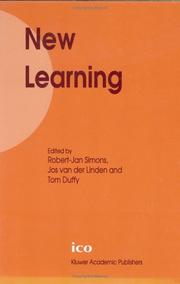| Listing 1 - 3 of 3 |
Sort by
|

ISBN: 0792385438 1441950915 1475767080 Year: 2000 Publisher: Boston Kluwer Academic
Abstract | Keywords | Export | Availability | Bookmark
 Loading...
Loading...Choose an application
- Reference Manager
- EndNote
- RefWorks (Direct export to RefWorks)
Integrating control theory, evolutionary psychology, and a hierarchical approach to personality, this book presents a new approach to motivation, personality, and consumer behavior. Called the 3M, which stands for `Meta-theoretic Model of Motivation', this theory seeks to account for how personality traits interact with the situation to influence consumer attitudes and actions. The book proposes that multiple personality traits combine to form a motivational network that acts to influence behavior. Mowen argues that in order to understand the causes of enduring behavioral tendencies, one must identify the more abstract traits underlying surface behaviors. In constructing the 3M model, the author reports data from fifteen empirical studies employing over 3500 respondents. In this hierarchical model, four types of personality traits are identified: elemental, compound, situational, and surface traits. Eight elemental traits are proposed as forming the underlying dimensions of personality. Consistent with control theory, the research reveals that the elemental traits combine to form compound traits, such as self-efficacy, task orientation, playfulness, and competitiveness. These elemental and compound traits combine with situational influences to cause enduring behavioral tendencies within general situational contexts. Examples of situational traits investigated include impulsive buying, value consciousness, sports interest, and health motivation. In the 3M model the elemental, compound, and situational traits combine to yield surface traits, which are enduring dispositions to act in specific behavioral contexts. Five surface traits are empirically investigated in the book: compulsive buying, sports participation, healthy diet lifestyles, proneness to bargaining, and a tendency to frugality. Across these five studies, the empirical results reveal that the 3M model accounts for over 44% of the variance in the surface trait measures. By presenting a new meta-theory of motivation and personality that is testable, Mowen's 3M model accounts for high levels of variance in consumer behavior. By integrating the work of selected past and current theorists into a comprehensible whole, the 3M model provides coherence in a field currently dominated by conflicting ideas, theories, and approaches. The book provides evidence that by understanding the individual dispositions that underlie consumer behavior, public policy officials and marketing specialists can develop better communication programs to influence and persuade their target audiences. The book shows how to employ the 3M model to segment the marketplace, provide psychographic inventories, position brands, create promotional themes, and develop brand personalities.
Consumers' preferences. --- Motivation research (Marketing) --- Personality. --- Social Sciences and Humanities. Consumer Studies --- Consumer Behaviour --- Motivation research (Marketing). --- Consumer Behaviour. --- Psychology. --- Social psychology. --- Marketing. --- Psychopharmacology. --- Psychology, general. --- Personality and Social Psychology. --- Behavioral pharmacology --- Drugs --- Chemotherapy --- Pharmacology --- Psychotropic drugs --- Consumer goods --- Domestic marketing --- Retail marketing --- Retail trade --- Industrial management --- Aftermarkets --- Selling --- Mass psychology --- Psychology, Social --- Human ecology --- Psychology --- Social groups --- Sociology --- Personal identity --- Personality psychology --- Personality theory --- Personality traits --- Personology --- Traits, Personality --- Individuality --- Persons --- Self --- Temperament --- Behavioral sciences --- Mental philosophy --- Mind --- Science, Mental --- Human biology --- Philosophy --- Soul --- Mental health --- Psychotropic effects --- Marketing

ISBN: 0792379489 144195001X 1475763263 Year: 2000 Publisher: Boston (Mass.) : Kluwer academic,
Abstract | Keywords | Export | Availability | Bookmark
 Loading...
Loading...Choose an application
- Reference Manager
- EndNote
- RefWorks (Direct export to RefWorks)
Recent legislative trends in the United States, the United Kingdom, and many other countries now require accurate and efficient assessment of environmental aesthetics. Most of this assessment is currently undertaken using traditional design judgment, but when the powers of the government are used to enforce policy the scope of the aesthetic evaluation requires consideration of questions such as `What concepts will aesthetic decision makers need to perform their intended function?', `How can they obtain the information they need?', and `What is currently known about environmental aesthetics?'. This book answers those questions with a solid, logical theory of environmental aesthetics, empirical evidence covering 277 studies, 41,000 respondents and 12,000 stimuli, and seven case histories showing how the theory can be applied to actual aesthetic decisions. The book proposes a unified protocol for measuring the magnitude of aesthetic impacts. It also applies that protocol to 94 specific findings which span a very wide range of issues.
Architectural design --- Architecture --- Methodology. --- Psychological aspects. --- Human factors. --- Psychology. --- Community psychology. --- Environmental psychology. --- Psychopharmacology. --- Psychotherapy. --- Counseling. --- Psychology, general. --- Community and Environmental Psychology. --- Psychotherapy and Counseling. --- Counselling --- Helping behavior --- Psychology, Applied --- Clinical sociology --- Interviewing --- Personal coaching --- Social case work --- Psychagogy --- Therapy (Psychotherapy) --- Mental illness --- Mental health counseling --- Behavioral pharmacology --- Drugs --- Chemotherapy --- Pharmacology --- Psychotropic drugs --- Cognitive ergonomics --- Ecological psychology --- Ecopsychology --- Ecotherapy --- Environmental quality --- Environmental social sciences --- Human factors science --- Psychoeology --- Psychology --- Psychotherapy --- Ecological Systems Theory --- Social psychology --- Behavioral sciences --- Mental philosophy --- Mind --- Science, Mental --- Human biology --- Philosophy --- Soul --- Mental health --- Treatment --- Psychotropic effects --- Psychological aspects

ISBN: 0792362969 9780792362968 9780306476143 9786610201006 1280201002 0306476142 Year: 2000 Publisher: Dordrecht Kluwer
Abstract | Keywords | Export | Availability | Bookmark
 Loading...
Loading...Choose an application
- Reference Manager
- EndNote
- RefWorks (Direct export to RefWorks)
The book you are now reading aims to bring together research and theory on "new learning, "which is te term used to refer to the new learning outcomes, new kinds of learning processes, and new instructional methods both wanted by society and currently stressed in psychological and educational theory. Many people keep asking about “new learning.” Is it really a new way of learning? Are there really new learning outcomes? Is this current fad really different from the other kinds of learning propagated by such traditional school innovators as Montessori, Dewey, Steiner, or Freinet? Of course, there are some similarities between the attention now being paid to new ways of learning and new learning outcomes and previous efforts. We believe, however, that at least three important differences exist. First, there is much more attention to the role of active, independent, and self-directed learning than before. Many more schools and teachers are involved in such efforts than in the twenties or the sixties, for example. Many governments are stimulating active ways to learn. Employers and employee organizations are — for various reasons — now in favor of active learning in school and on the job. This is clearly related to increased recognition of the importance of and need for life-long learning and what are now called “learning organizations” as a result of rapidly changing societies and economies.
Didactics --- Learning. --- Educational change. --- Apprentissage --- Enseignement --- Réforme --- Educational change --- Learning --- #PBIB:2001.1 --- #PBIB:2001.4 --- #PBIB:gift 2001 --- #KVHA:Taalonderwijs --- #KVHA:Didactiek --- didactiek --- studiemethode --- Learning process --- Comprehension --- Education --- Change, Educational --- Education change --- Education reform --- Educational reform --- Reform, Education --- School reform --- Educational planning --- Educational innovations --- Artificial intelligence. --- Consciousness. --- Philosophy (General). --- Theory & Practice of Education --- Social Sciences --- Psychology. --- Personality. --- Social psychology. --- Cognitive psychology. --- Psychology, general. --- Learning & Instruction. --- Cognitive Psychology. --- Personality and Social Psychology. --- Artificial Intelligence (incl. Robotics). --- Artificial Intelligence. --- Instruction. --- AI (Artificial intelligence) --- Artificial thinking --- Electronic brains --- Intellectronics --- Intelligence, Artificial --- Intelligent machines --- Machine intelligence --- Thinking, Artificial --- Bionics --- Cognitive science --- Digital computer simulation --- Electronic data processing --- Logic machines --- Machine theory --- Self-organizing systems --- Simulation methods --- Fifth generation computers --- Neural computers --- Mass psychology --- Psychology, Social --- Human ecology --- Psychology --- Social groups --- Sociology --- Personal identity --- Personality psychology --- Personality theory --- Personality traits --- Personology --- Traits, Personality --- Individuality --- Persons --- Self --- Temperament --- Psychology, Cognitive --- Behavioral sciences --- Mental philosophy --- Mind --- Science, Mental --- Human biology --- Philosophy --- Soul --- Mental health
| Listing 1 - 3 of 3 |
Sort by
|

 Search
Search Feedback
Feedback About UniCat
About UniCat  Help
Help News
News